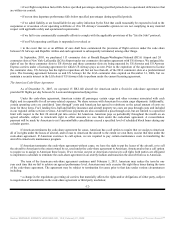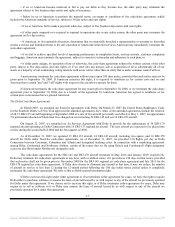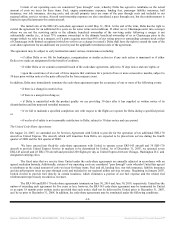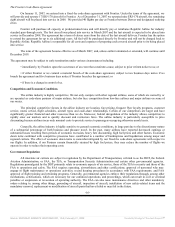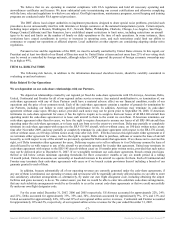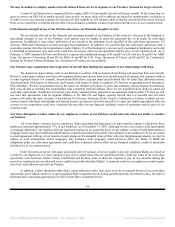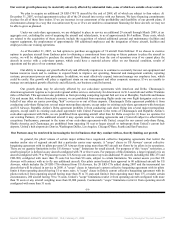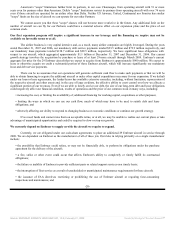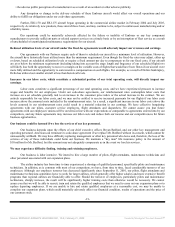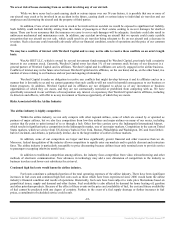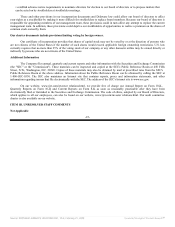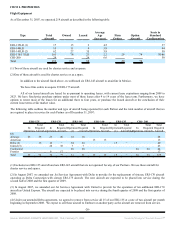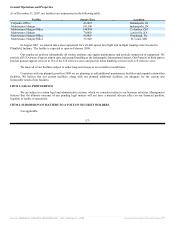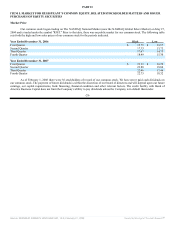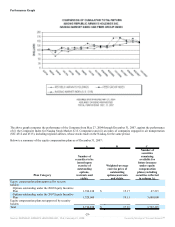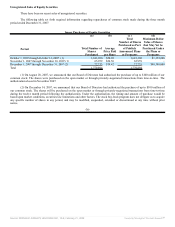Frontier Airlines 2007 Annual Report Download - page 28
Download and view the complete annual report
Please find page 28 of the 2007 Frontier Airlines annual report below. You can navigate through the pages in the report by either clicking on the pages listed below, or by using the keyword search tool below to find specific information within the annual report.
We are at risk of losses stemming from an accident involving any of our aircraft.
While we have never had a crash causing death or serious injury over our 34 year history, it is possible that one or more of
our aircraft may crash or be involved in an accident in the future, causing death or serious injury to individual air travelers and our
employees and destroying the aircraft and the property of third parties.
In addition, if one of our aircraft were to crash or be involved in an accident we would be exposed to significant tort liability.
Such liability could include liability arising from the claims of passengers or their estates seeking to recover damages for death or
injury. There can be no assurance that the insurance we carry to cover such damages will be adequate. Accidents could also result in
unforeseen mechanical and maintenance costs. In addition, any accident involving an aircraft that we operate could create a public
perception that our aircraft are not safe, which could result in air travelers being reluctant to fly on our aircraft and a decrease in
revenues. Such a decrease could materially adversely affect our financial condition, results of operations and the price of our common
stock.
We may have conflicts of interest with Wexford Capital and we may not be able to resolve these conflicts on an arm's length
basis.
WexAir RJET LLC, which is owned by several investment funds managed by Wexford Capital, previously held a majority
interest in our common stock. Currently, Wexford Capital owns less than 1% of our common stock but one of our directors is a
general partner of Wexford Capital and its affiliates. Wexford Capital and its affiliates are actively engaged in the airline business.
Conflicts of interest may in the future arise between Wexford Capital and its affiliates, on the one hand, and us, on the other hand, in a
number of areas relating to our business and our past and ongoing relationships.
Wexford Capital is under no obligation to resolve any conflicts that might develop between it and its affiliates and us in a
manner that is favorable to us and we cannot guarantee that such conflicts will not result in harmful consequences to our business or
future prospects. In addition, Wexford Capital and its affiliates are not obligated to advise us of any investment or business
opportunities of which they are aware, and they are not contractually restricted or prohibited from competing with us. We have
specifically renounced in our certificate of incorporation any interest or expectancy that Wexford Capital and its affiliates, including
its directors and officers, will offer to us any investment or business opportunity of which they are aware.
Risks Associated with the Airline Industry
The airline industry is highly competitive.
Within the airline industry, we not only compete with other regional airlines, some of which are owned by or operated as
partners of major airlines, but we also face competition from low-fare airlines and major airlines on many of our routes, including
carriers that fly point to point instead of to or through a hub. Other low-fare carriers serve the Indianapolis International Airport,
which results in significant price competition in the Indianapolis market, one of our major markets. Competition in the eastern United
States markets, which we service from US Airways' hubs in New York, Boston, Philadelphia and Washington, D.C.and from Delta's
hub in Cincinnati, and Atlanta, is particularly intense, due to the large number of carriers in those markets.
In addition, some of our competitors are larger and have significantly greater financial and other resources than we do.
Moreover, federal deregulation of the industry allows competitors to rapidly enter our markets and to quickly discount and restructure
fares. The airline industry is particularly susceptible to price discounting because airlines incur only nominal costs to provide service
to passengers occupying otherwise unsold seats.
In addition to traditional competition among airlines, the industry faces competition from video teleconferencing and other
methods of electronic communication. New advances in technology may add a new dimension of competition to the industry as
business travelers seek lower-cost substitutes for air travel.
Continued high fuel costs would harm the airline industry.
Fuel costs constitute a substantial portion of the total operating expenses of the airline industry. There have been significant
increases in fuel costs and continued high fuel costs such as those which have been experienced since 2006 would harm the airline
industry's financial condition and results of operations. Historically, fuel costs have been subject to wide price fluctuations based on
geopolitical issues, supply and demand and other factors. Fuel availability is also affected by demand for home heating oil, gasoline
and other petroleum products. Because of the effect of these events on the price and availability of fuel, the cost and future availability
of fuel cannot be predicted with any degree of certainty. Further, in the event of a fuel supply shortage or further increases in fuel
prices, a curtailment of scheduled service could result.
-22-
Source: REPUBLIC AIRWAYS HOLDINGS INC, 10-K, February 21, 2008 Powered by Morningstar® Document Research℠


